Jazz Guitar Chord Theory (part 1)
How are guitar chords built? What makes a chord minor or major? If you’re not sure about this then read on … Some background theory makes a tremendous help when learning how to play guitar chords. Let’s get started with the C major scale :
(chords that are built with 4 or more notes) are based on thirds. There are 2 kinds of thirds (or 3rds) :
Let’s start by stacking 2 thirds on the 1 (first note) of the C major scale:
|
The result is a C major triad or C. From C to E is a major third
and from E to G a minor third : every major chord has this structure.
The thing to remember here is what we call the chord formula for major chords: 1 3 5
Another thing to remember : another name for the 1 of a chord is the root.
The thing to remember here is what we call the chord formula for major chords: 1 3 5
Another thing to remember : another name for the 1 of a chord is the root.
Let’s do the same for the 2 of the C major scale :
| D F A |
| 1 b3 5 |
The result is a D minor triad or Dm. From D to F is a minor third and
from F to A is a major third : every minor chord has this structure.
Again the thing to remember is the chord formula for minor chords : 1 b3 5
Again the thing to remember is the chord formula for minor chords : 1 b3 5
Now we’re going to skip a few notes and stack thirds on the 7 of the C major scale :
| B D F |
| 1 b3 b5 |
The result now is a B diminished triad or Bdim. From B to D is a minor third and f
rom D to F is also a minor third : every diminished triad chord has this structure.
So the chord formula of diminished chords is : 1 b3 b5
So the chord formula of diminished chords is : 1 b3 b5
I’ll summarize and complete the other notes of the C major scale :
| Notes | Formula | Chord Name | Symbol | |
| 1 | C E G | 1 3 5 | C major | C |
| 2 | D F A | 1 b3 5 | D minor | Dm or D- or Dmin |
| 3 | E G B | 1 b3 5 | E minor | Em or E- or Emin |
| 4 | F A C | 1 3 5 | F major | F |
| 5 | G B D | 1 3 5 | G major | G |
| 6 | A C E | 1 b3 5 | A minor | Am or A- or Amin |
| 7 | B D F | 1 b3 b5 | B diminished | Bdim or B° |
1. The first way starts from the major scale.
- Find the major scale of a given key. If you’re not sure how to do this,go here: How To Construct a Major Scale. If you need to findfor example the notes of a Gm chord then find the G major scale : G A B C D E F#
- Construct the major chord : 1 3 5. In our G major example that would be : G B D
- Apply the chord formula to the major chord. The chord formula for minor
- chords is 1 b3 5. This means the 3rd of the major chord has to be lowered half a step : G Bb D
2. The second way involves some memorization and will be explained in part 4,
after we covered seventh chords and tensions.
Jazz Guitar Chord Theory (part 2)
In part 1 of jazz guitar chord theory we covered the construction of triads, chords that contain 3 different notes. If you are new to chord theory, I suggest you read part 1 first.
Let’s get started again with the C major scale :
| C Major Scale | C D E F G A B |
| 1 2 3 4 5 6 7 |
The construction of seventh chords follows the same principle as constructing triads : stacking 3rds on top of each other.
Triads were made by stacking 2 thirds on top of the root. Seventh chords are constructed by stacking 3 thirds on top of the root.
Triads were made by stacking 2 thirds on top of the root. Seventh chords are constructed by stacking 3 thirds on top of the root.
Let’s stack 3 thirds on the 1 of the C major scale :
| C E G B |
| 1 3 5 7 |
The result is a C major 7 chord or Cmaj7. From C to E is a major third, from E to G is a minor third and from G to B is a major third : every major 7 chord has this structure.
So the chord formula for major 7 chords is : 1 3 5 7
So the chord formula for major 7 chords is : 1 3 5 7
Let’s do the same for the 2nd note of the C major scale :
| D F A C |
| 1 b3 5 b7 |
The result is a D minor 7 chord or Dmin7. From D to F is a minor third, from F to A is a major third and from A to C is a minor third : every minor 7 chord has this structure.
So the chord formula for minor 7 chords is : 1 b3 5 b7
So the chord formula for minor 7 chords is : 1 b3 5 b7
Now let’s skip some notes and stack 3 thirds on top of the 5th note of the C major scale :
| G B D F |
| 1 3 5 b7 |
The result is a G dominant 7 chord or G7. From G to B is a major third, from B to D is a minor third and from D to F is a minor third : every dominant 7 chord has this structure.
The chord formula for dominant 7 chords is : 1 3 5 b7
The chord formula for dominant 7 chords is : 1 3 5 b7
We’ll skip some more notes and stack 3 thirds on top of the 7th note of the C major scale :
| B D F A |
| 1 b3 b5 b7 |
The result is a B half diminished chord or Bm7b5. From B to D is a minor third, from D to F is a minor third and from F to A is a major third : every half diminished 7 chord has this structure.
The chord formula for half diminished 7 chords is : 1 b3 b5 b7
The chord formula for half diminished 7 chords is : 1 b3 b5 b7
I’ll summarize and complete the other notes of the C major scale :
| Notes | Formula | Chord Name | Symbol | |
| 1 | C E G B | 1 3 5 7 | C major 7 | Cmaj7 |
| 2 | D F A C | 1 b3 5 b7 | D minor 7 | Dm7 or D-7 or Dmin7 |
| 3 | E G B D | 1 b3 5 b7 | E minor 7 | Em7 or E-7 or Emin7 |
| 4 | F A C E | 1 3 5 7 | F major 7 | Fmaj7 |
| 5 | G B D F | 1 3 5 b7 | G dominant | G7 |
| 6 | A C E G | 1 b3 5 b7 | A minor 7 | Am7 or A-7 or Amin7 |
| 7 | B D F A | 1 b3 b5 b7 | B half diminished | Bm7b5 or Bmin7b5 |
Jazz Guitar Chord Theory (part 3)
In part 2 we had a look at how seventh chords are constructed. In part 3 we’ll focus our attention on tensions.
Tensions are notes that are part of a chord, but are not chord tones (1 3 5 7).
Let’s have a look again at the C major scale :
| C Major Scale | C D E F G A B |
| 1 2 3 4 5 6 7 |
If we construct a chord on C, we get a Cmaj7 :
| C E G B |
| 1 3 5 7 |
There are 3 notes left in the major scale that are not chord tones : 2, 4 and 6.
If we add these tones to the chord, they become tensions.
Most of the time we play tensions an octave higher then the chord tones because else they might get in the way of the chord tones (the chord would sound ‘muddy’ most of the time). That’s also the way they are notated : 2 becomes 9 (2+7(one octave)=9), 4 becomes 11 and 6 becomes 13.
If we add these tones to the chord, they become tensions.
Most of the time we play tensions an octave higher then the chord tones because else they might get in the way of the chord tones (the chord would sound ‘muddy’ most of the time). That’s also the way they are notated : 2 becomes 9 (2+7(one octave)=9), 4 becomes 11 and 6 becomes 13.
So if we add the 2 to Cmaj7 we get Cmaj9
| C E G B D |
| 1 3 5 7 9 |
The two other notes that are left, the 4 and 6, are special cases in combination with a major chord.
First of all here is something we call avoid notes : notes that are a half tone above a chord tone. Avoid notes sound disharmonic so they are almost never used.
If we have a look at the 4 of the C major scale we notice that it is a half step above the e, what is the 3rd of Cmaj7. So the 4 (f) is an avoid note for Cmaj7.
A solution for this is to raise the 4 a half tone: f becomes f# and is no longer an avoid note and the basic scale is no longer C major, but C Lydian (see jazz guitar modes). This chord would be called Cmaj7(#11).
If we have a look at the 4 of the C major scale we notice that it is a half step above the e, what is the 3rd of Cmaj7. So the 4 (f) is an avoid note for Cmaj7.
A solution for this is to raise the 4 a half tone: f becomes f# and is no longer an avoid note and the basic scale is no longer C major, but C Lydian (see jazz guitar modes). This chord would be called Cmaj7(#11).
The 6 is also a special case in combination with major chords. Most of the times when we add a 6 to a major chord, the 7 is omitted and there is no octave added to the 6. This is because the 6 and 7 might get in each other’s way.
So if we add the 6 to C major we get a C6 :
So if we add the 6 to C major we get a C6 :
| C E G A |
| 1 3 5 6 |
The same goes for 6 in combination with a minor chord : the 7 is omitted.
If we add the 6 to Dm7 we get Dm6 (Look out : the 6 is no longer A because the root of the chord changed to D. The six is now B (D E F G A B C) :
If we add the 6 to Dm7 we get Dm6 (Look out : the 6 is no longer A because the root of the chord changed to D. The six is now B (D E F G A B C) :
| D F A B |
| 1 b3 5 6 |
The 4 is not an avoid note in combination with minor chords because it is two half tones above the b3 and not one half.
So we can safely add the 4 to Dm7 and we get Dm11 :
So we can safely add the 4 to Dm7 and we get Dm11 :
| D F A C G |
| 1 b3 5 b7 11 |
The 4 is also a special case in combination with dominant chords.
When a 4 is added to a dominant chord, the 3 is omitted. Chords like these are called sus4 chords.
Chords like these often function as a delay for a dominant chord.
Sus4 chords often come with a 9 on the guitar :
When a 4 is added to a dominant chord, the 3 is omitted. Chords like these are called sus4 chords.
Chords like these often function as a delay for a dominant chord.
Sus4 chords often come with a 9 on the guitar :
| G C D F A |
| 1 4 5 b7 9 |
There’s also something called altered tensions (b9, #9, b5, b13). This topic is covered later in another lesson.
The different chord types and their tensions :
| Chord Type | Added Note | Symbol | |
| Major | 2 | Cmaj9 | |
| 4 #4 | / Cmaj7#11 | avoid note. #11 comes out of lydian scale | |
| 6 | C6 | omitted 7 | |
| Minor | 2 | Cm9 | |
| 4 | Cm11 | ||
| 6 | Cm6 | omitted 7 | |
| Dominant | 2 b2 #2 | C9 C7(b9) C7#9 | b2 and #2 come out of altered scale |
| 4 | C7sus4 | ||
| 6 b6 | C13 C7(b13) | b6 comes out of altered scale |
Jazz Guitar Chord Theory (part 4)
In jazz guitar chord theory part 3 we had a look at chord tensions.
In part 4 we’ll summarize the chord formulas and have a look at some examples.
In part 4 we’ll summarize the chord formulas and have a look at some examples.
Here’s a summary of the chord formulas we covered until now + some additional chord types :
| Chord Type | Chord Formula |
| Major Triad | 1 3 5 |
| Minor Triad | 1 b3 5 |
| Diminished Triad | 1 b3 b5 |
| Augmented Triad | 1 3 #5 |
| Major 7 | 1 3 5 7 |
| Minor 7 | 1 b3 5 b7 |
| Dominant 7 | 1 3 5 b7 |
| Half Diminished 7 | 1 b3 b5 b7 |
| Diminished 7 | 1 b3 b5 bb7 |
| Augmented 7 | 1 3 #5 b7 |
| Suspended 4 | 1 4 5 b7 |
| minor/major 7 | 1 b3 5 7 |
In jazz guitar chord theory part 1we saw the first way to construct chords.
Here’s anther way :
Here’s anther way :
- The first step is memorizing the chords and chord tones of the C major scale and the chord formula‘s:
You must be able to picture the chord types and chord tones of C major without thinking.Cmaj7 C E G B Dm7 D F A C Em7 E G B D Fmaj7 F A C E G7 G B D F Am7 A C E G Bm7b5 B D F A - Now that you know the chords of C major, it’s easy to find chords of other keys.For example : to find the chord tones of Cm7 :
- You know the chord tones of Cmaj7 : C E G B
- You know the chord formula of Cmaj7 : 1 3 5 7
- You know the chord formula of minor 7 : 1 b3 5 b7
- Adapt the chord tones of Cmaj7 to the formula of minor 7 : bring the 3 and the 7 a half step down
- Conclusion : the chord tones of Cm7 are : C Eb G Bb
Example 2 : the chord tones of Ddim7 :
- You know the chord tones of Dm7 : D F A C
- You know the formula of Dm7 : 1 b3 5 b7
- You know the formula of diminished 7 : 1 b3 b5 bb7
- Adapt the chord tones of Dm7 to the formula of diminished 7 : bring the 5 and the 7 a half step down
- Conclusion : the chord tones of Ddim7 are : D F Ab B
Example 3 : the chord tones of F#7 :
- You know the chord tones of Fmaj7 : F A C E
- To find the chord tones of F#maj7 you just have to raise each chord tone a half step : F# A# C# E#
- You know the formula of major 7 : 1 3 5 7
- You know the formula of dominant 7 : 1 3 5 b7
- Adapt the chord tones of F#maj7 to the formula of dominant 7 : bring the 7 a half step down
- Conclusion : the chord tones of F#7 are : F# A# C# E
-
Jazz Guitar Chord Theory (part 5)
Now you know how to find the notes of a chord, but how do you translate this to the guitar?
For starters: here are 2 chord charts that will help you in the process.
The first thing you need to know is that not every chord tone is equally important :
- 3 and 7 are the important notes of a chord because they decide the chord type. They are also important for voice leading.
- The 1 is the least important note, because it is most of the time played by the bass player.
- The 5 is not so important either and can be disturbing sometimes.
- Tensions add color and interest to a chord, so it’s preferable to use tensions instead of 1 and 5.
Another thing you need to know is that 1 half step equals one fret on the guitar.
Here’s an example with guitar chord diagrams :
- We’ll start with a C triad : C E G (1 3 5)
Let’s have a look at the guitar chord diagram :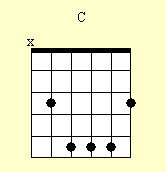
X15135 : C from left to right (from low E string to high E string) we have here :
- X : the low E-string is not played
- 1 : the 1 or root of the chord is played on the A-string
- 5 : the 5th of the chord is played on the D-string
- 1 : again the root, but now on the G-string
- 3 : the third is played on the B-string
- 5 : the 5th is played again, but this time on the high E-string
This chord doesn’t sound very jazzy though, so let’s spice it up a bit :
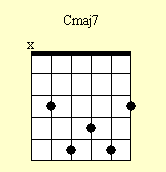
X15735 : Cmaj7
Instead of duplicating the root on the G-string, we exchanged it for the 7 of the chord.
Now let’s add some color :
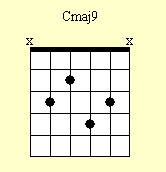
X1379X : Cmaj9
We exchanged the 5th on the D-string for the 3rd and we changed the 3rd on the B-string to a 9.
This would be a nice chord if you’re playing bossa nova, solo guitar or in duo setting, but if you play with a bass player and you don’t want to get in his way, it’s better to omit the root and to play on the higher strings only :

XX3795 : Cmaj9/E
Instead of playing the root of the chord, we now play the 5th on the high E-string.
A chord like this is called a chord inversion : a chord that has a note other then the root in the bass. There are three types of chord inversions : with the 3rd in the bass (first inversion), with the 5th in the bass (second inversion) or with the 7 in the bass (third inversion).
In our example we have got a Cmaj9 chord with the 3rd (E) in the bass.
Now what needs to happen if we want to make this chord dominant?
Simple : the 7 has to go a half step down (major is 1 3 5 7, dominant is 1 3 5 b7).
Have a look at the chord diagram:
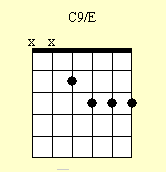
XX3b795 : C9/E
And if we want to make this chord minor?
Starting from the dominant chord we have to lower the 3rd a half step, as you can see on the guitar chord diagram:
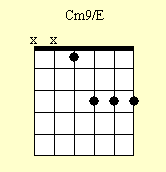
XXb3b795 : Cm9/E -
A great tool to help you with the constuction of guitar chords is the guitar chord finder.
To conclude our tutorial I give you some chords where you need to find the chord tones of
(the solutions are on the next page) :
For example : Fm7 : F Ab C Eb
Now it’s your turn :
Gm7 :
Abmaj7 :
C#maj7 :
A9sus4 :
B7 :
Edim7 :
Gdim7 :
D7b9 :
D#m7b5 :
Dmaj7 :
Abmaj7 :
C#maj7 :
A9sus4 :
B7 :
Edim7 :
Gdim7 :
D7b9 :
D#m7b5 :
Dmaj7 :
Jazz Guitar Chord Theory (part 6)
The solutions to the chord exercises of guitar chord theory part 5 :
Gm7 : G Bb D F
Abmaj7 : Ab C Eb G
C#maj7 : C# E# G# B#
A9sus4 : A D E G B
B7 : B D# F# A
Edim7 : E G Bb Db
Gdim7 : G Bb Db E
D7b9 : D F# A C Eb
D#m7b5 : D# F# A C#
Dmaj7 : D F# A C#
Abmaj7 : Ab C Eb G
C#maj7 : C# E# G# B#
A9sus4 : A D E G B
B7 : B D# F# A
Edim7 : E G Bb Db
Gdim7 : G Bb Db E
D7b9 : D F# A C Eb
D#m7b5 : D# F# A C#
Dmaj7 : D F# A C#
No comments:
Post a Comment